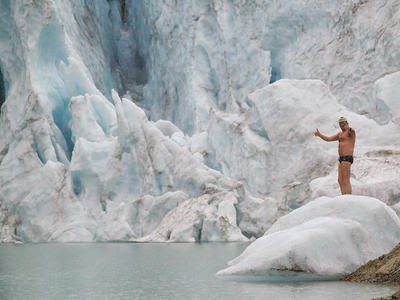 Courtesy of WOWSA, Huntington Beach, California.
Courtesy of WOWSA, Huntington Beach, California.
In the open water world, distances are measured from point to point along the straight line tangent. If the open water swim is held in a rectangular course, the course is measured from buoy to buoy along the straight line tangent.
This necessarily means that open water swimmers swim further than the actual distance of the course as they have to round buoys and swim in and around packs of swimmers and take different angles at different times.
We suspect that regulated and authorized ice miles will soon be measured similarly and not occasionally measured by GPS watches worn by swimmers. Ram Barkai, co-founder of the International Ice Swimming Association, says, “We have to amend the rules to be more specific about measuring distances. It will mean that swimmers will actually cover more than a mile. We always measure a clear course of 1650m.”
However a course is measured, anything around a statute mile (officially 1,609 meters*), swimming for that long in water under 5ºC is inherently risk.
“We are adapting to the sport’s growth and our learnings,” explains Barkai. “Many people coming to the ice for different reasons and want the sport the adapt to their objectives of what they want to get out of the sport. I started the ice as an adventure and exploration of the human mind and what is possible. I realised very quickly that most sportsman see competitiveness as speed while I discovered something, but not through speed.
I don’t want to encourage swimmers to compete in ice miles. We are not making it a race. However, we cannot punish people who wish to run into the water or race the ice mile. It is a personal choice. Some see a race in everything they do; I see an adventure in everything I do.”
But even ice miles completed in different locations in different times are different for an obvious reason. Barkai describes the situation. “You can’t compare a swim between 0ºC and 5ºC. Each swim is done in different environment. I don’t think we can normalise these [different] swims and have a standard. But we can create interest in our sport by crediting some of the top swimmers and inspiring others to do more.”
The International Ice Swimming Association has now recognized 172 ice miles done by 131 swimmers from 23 countries. “The mile swims are fascinating and we are going to add to their appeal soon by awarding swimmers who have done 5 or more and 10 or more ice miles. For some, it is once-in-a-lifetime swim and for some it is a continuous challenge,” says Barkai who has done 8 official ice miles and several more unofficial ice miles with more than 10 1 km+ ice swims.
He looks forward to the continued development in the sport of ice swimming. “The evolution of seconds, coaches, officials and specialised medics is in the pipeline. I see more and more people capitalising and monetising on the ice. Some will curve a career that will also help the sport to grow. There is growing interest in training camps and techniques.
I come from background of risk: army and finance. I remember those who specialised in risk monitoring; they were not the ones who knew how to take high risks and survive. It requires different mindsets and we need both. One is a wild horse raring to go and one is his rider who is trying to maintain control. We need both.
I don’t want to only focus the sport on risk and safety and I don’t want to only focus the sport on speed and distance. It is natural that risk watchers will spot the risk and risk takers will spot opportunity.
* a nautical mile is 1,852 meters
Copyright © 2015 by World Open Water Swimming Association